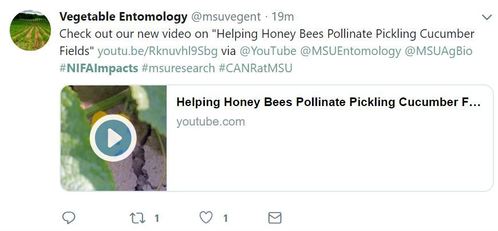|
Having trouble viewing this email? View it as a Web page.

|
|
|
Fresh from the Field is a weekly album showcasing transformative impacts made by partners supported by the National Institute of Food and Agriculture.
Editor: Falita Liles Dec.13, 2018
|
|
|
Fresh From the Field will be on hiatus until January 10, 2019. NIFA wishes you a healthy, and safe holiday season.
Success Stories
 Agents of Change Saving the Citrus Industry in Puerto Rico
Citrus greening (CG) disease was responsible for the loss of nearly half a million tons of citrus in the United States in 2017. CG is a bacterial disease transmitted by the Asian citrus psyllid. The bacteria establishes itself in the infected tree’s vascular system, disrupting the movement of nutrients from shoots to roots. The immediate results are green and bitter fruits unsuitable for the market; the disease eventually causes death of the tree. Researchers have developed and tested better management practices to treat the symptoms of CG, including nutritional sprays and screening for resistant varieties.
In Puerto Rico, the citrus industry is valued at $4.25 million. The first reports of CG disease in Puerto Rico came in 2009 and is spreading at an alarming rate. Puerto Rico’s Agricultural Extension Service is working closely with growers to help them adopt Integrated Pest Management (IPM) practices to manage CG through hands-on training and the development of a demonstrational farm.
Extension specialists, including Fruit Specialist Jose Zamora, are providing workshops to test different fertilizers to identify the best treatment. In addition, they will use drones equipped with multispectral cameras to detect infection symptoms and crop damage.
In 2018, the Puerto Rico project held five workshops with field demonstrations. Thirty eight citrus farmers, six extension agents, five USDA agronomists, four Natural Resources Conservation Service technicians, and four agronomists visiting from Italy received IPM training for CG management as well. Six farmers have already adopted some of the management practices on their farms.
NIFA supports this research and extension through the Crop Protection and Pest Management Program.
|
News Coverage
 VetLink Mobile App at Prairie View A&M: Agricultural Technology Breaking Through Barriers
Many livestock farmers, including goat producers, are located in remote or mountainous areas, and veterinarians are not nearby when livestock become ill. Goats are notorious explorers and climbers and are known for occasionally escaping from their farms and getting lost or injured.
Issues like these led to VetLink, a mobile goat application developed by Dr. Paul Johnson, a research scientist in Prairie View A&M University’s Cooperative Agricultural Research Center (CARC).
Johnson is leading a collaborative project that leverages current technology and advances it toward solutions that address Project 2050 challenges – the goal of increasing food and feed production in order to feed the world’s growing population. Johnson has developed a database of animal management issues and an interactive blog that helps small ruminant producers preserve a sustainable food source that supports themselves and the greater community.
NIFA supports the research through the 1890 Capacity Building Grants Program.
Read more about VetLink at PVAMU’s website.
|
Library
 Toximap: Predicting the Incidence of Mycotoxins in US Crop Fields
Researchers at the University of South Carolina (USC) are developing a novel approach to predict the presence of aflatoxin in US crop fields before harvest. Aflatoxins, carcinogenic toxins produced by fungi in the Aspergillus (mold) family, occur in the soil and in decaying vegetation. These toxins can easily contaminate crops such as corn, peanuts, and tree nuts. Aflatoxins can cause cancer and child stunting, with more than 5 billion people at risk. The costs of managing aflatoxin ranges from $1-2.5 billion annually. Aflatoxin production relies heavily on several environmental factors, such as temperature, water activity, and humidity. USC’s Toximap is a computational tool for predicting incidence of aflatoxin in the United States and is critical to reducing and preventing contamination.
NIFA supports Toximap through the Agricultural Food and Research Initiative.
|
Tweet of the Week
#NIFAIMPACTS

|
|

NIFA’s mission is to invest in and advance agricultural research, education, and extension that solve societal challenges. NIFA’s investments in transformative science directly support the long-term prosperity and global preeminence of U.S. agriculture. To learn more about NIFA’s impact on agricultural sciences, visit www.nifa.usda.gov/Impacts, sign up for email updates or follow us on Twitter @USDA_NIFA, #NIFAImpacts.
USDA is an equal opportunity lender, provider, and employer.
|
|